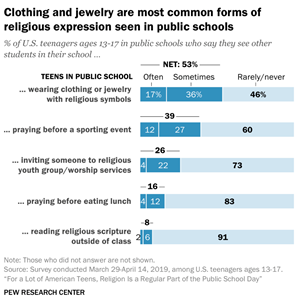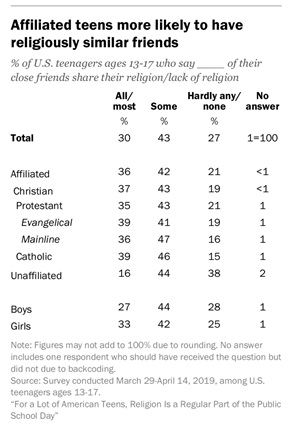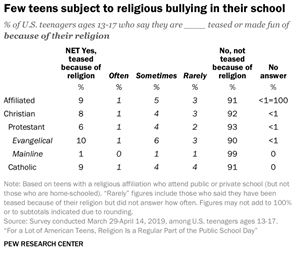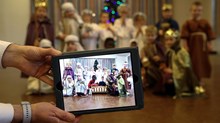
Has faith faded from public schools, or do today’s religiously unaffiliated teens simply overlook it?
Evangelical students notice far more Christian expression in US public schools than their peers do overall and are more willing to engage in conversations with their friends about what they believe, according to a new report out today from the Pew Research Center, the first of its kind.
The release coincides with Focus on the Family’s sixth Bring Your Bible to School Day, when half a million teens are expected to bring a Bible to school as a way to celebrate First Amendment freedoms and share their faith. If the survey is any indication, evangelical public school students are far more likely than their religiously unaffiliated peers to notice the flood of Bibles.
Pew found that evangelical teens are six times more likely than religiously unaffiliated teens to notice students reading Scripture in school outside of class (18% vs. 3%) and nearly three times more likely than the unaffiliated to witness student prayer before lunch (25% vs. 9%) or to see someone invited to a youth group or worship service (45% versus 17%).
“There are substantial differences in what [religious expressions] students tend to see in public school depending on the student’s religious affiliation,” Pew’s report states. But “it is not completely clear what accounts for such large differences.”
Evangelicals’ heightened awareness of faith expressions could be influenced by a “tendency to have religiously similar friendship circles,” according to Pew researchers. Alternately, “religious and nonreligious teens may perceive the world somewhat differently: What may appear as a religious expression to an evangelical Protestant teen may not even be noticed by a nonreligious teen.”

Among all religiously affiliated teens, 31 percent say they personally wear clothing or jewelry with religious symbols to public school, 26 percent pray before eating lunch, and 24 percent invite fellow students to religious activities. Evangelical public school students do all three at higher rates: 38 percent wear religious clothing or jewelry, 39 percent pray before eating lunch, and 43 percent invite peers at school to religious youth groups or worship services.
The biggest gap between evangelicals and fellow students is over whether they actually talk about their faith with their friends at school. A majority of evangelical teens (59%) say they do, compared to fewer than half of mainline Protestants, a third of Catholics, and about one-in-five religious nones.
Richard Ross, a youth ministry leader for five decades, said he has observed a decline in religious expressions at public schools, but he blames Christian adults rather than students.
Almost all evangelical denominations and parachurch groups “are seeing changes in the ways youth ministers are challenging their teenagers,” said Ross, professor of student ministry at Southwestern Baptist Theological Seminary. On average, “younger youth pastors have softened their call to students to have gospel conversations at school” and “are not networking their efforts in order to establish evangelistic campus clubs on school campuses.”

As a result, he said, “teenage baptisms in almost every evangelical group are dropping precipitously."
A majority of teens in general (82%) and evangelical teens (64%) say there are no religious support or prayer groups that meet in their school.
Legal rights around faith in schools
Religious persecution is an issue in public schools, Pew found, but only in a limited manner. A full 86 percent of teens in general and 82 percent of evangelicals say they rarely or never witness students in their school being teased or made fun of because of their religion.
Matt Sharp, senior counsel with the conservative legal organization Alliance Defending Freedom, said public schools “are generally accommodating religious expression,” though there is occasional conflict between administrators and students of faith.
Disputes used to center on “whether religious clubs and religious speech can even happen in the schools,” Sharp said, with some schools attempting to prohibit students from founding Bible clubs and handing out Christian literature. Today the law is “well settled” to allow those activities, so legal battles have shifted to “a clash between religious expression and other students’ being offended” by it.

Some public schools, Sharp said, have attempted to bar Christian clubs from requiring their leaders to be Christians, but those cases have not gone to court. Similar cases have been litigated in higher education.
Pew found teens know the law well when it comes to teacher-led class prayer. Eighty-two percent stated correctly that the practice has been ruled unconstitutional by the US Supreme Court. Nonetheless, 41 percent of teens in public schools, including 68 percent of evangelicals, said they view teacher-led prayer in class as appropriate.
The Supreme Court ruled in 1962 that teachers and administrators cannot lead prayers in public schools. In 2000, the court prohibited school districts from sponsoring student-led prayers at football games.
Still, 8 percent of teens said they have had a public school teacher lead a class in prayer. More students in the South (12%) have witnessed teacher-led prayer than in any other region. Students reported teacher-led prayer at lower rates in the Midwest (7%), West (6%), and Northeast (2%).
Though the Supreme Court has ruled teachers may read from the Bible as literature, only about a third of students (36%) know their teachers are allowed to do so. Fifty-five percent—and 82 percent of evangelicals—believe it is appropriate for teachers to read the Bible as literature in class.
Sharp urged students to know their rights of religious expression in public school, which “are much more broad than people realize.”
While 82 percent of evangelical teens attend public school, evangelicals have the highest homeschooling rate (11%) of any religious group surveyed.
Last year, a Barna study found that 13 percent of Gen Z members between 13 and 18 years old consider themselves atheists, compared to just 6 percent of adults. Meanwhile, 59 percent of Gen Z identifies as Christian, compared to 68 percent of adults.
Although no similar data on public school religious expression exits from past years, Gallup polls have shown a gradual decline in support for school prayer. Support for student-led prayer at graduation programs declined from 83 percent in 1999 to 75 percent in 2014. Support for daily spoken prayer in the classroom declined from 70 percent to 61 percent over the same period.
David Roach is a writer in Nashville, Tennessee

Support Our Work
Subscribe to CT for less than $4.25/month




















